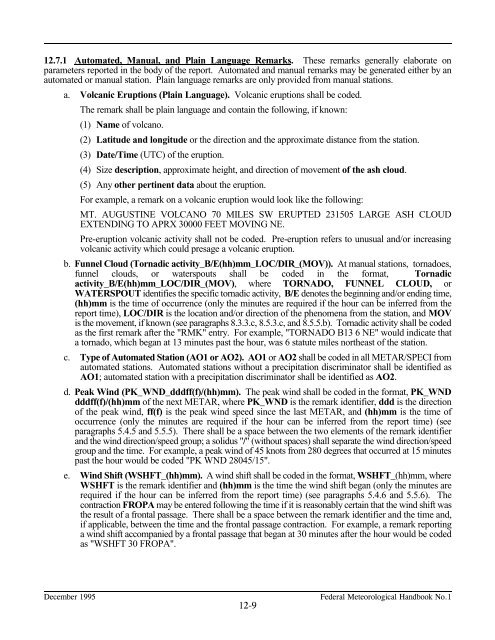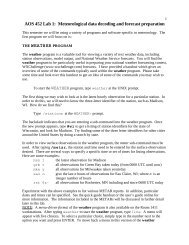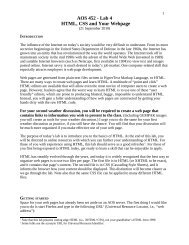Federal Meteorological Handbook No. 1 - Marrella
Federal Meteorological Handbook No. 1 - Marrella
Federal Meteorological Handbook No. 1 - Marrella
Create successful ePaper yourself
Turn your PDF publications into a flip-book with our unique Google optimized e-Paper software.
12.7.1 Automated, Manual, and Plain Language Remarks. These remarks generally elaborate on<br />
parameters reported in the body of the report. Automated and manual remarks may be generated either by an<br />
automated or manual station. Plain language remarks are only provided from manual stations.<br />
a. Volcanic Eruptions (Plain Language). Volcanic eruptions shall be coded.<br />
The remark shall be plain language and contain the following, if known:<br />
(1) Name of volcano.<br />
(2) Latitude and longitude or the direction and the approximate distance from the station.<br />
(3) Date/Time (UTC) of the eruption.<br />
(4) Size description, approximate height, and direction of movement of the ash cloud.<br />
(5) Any other pertinent data about the eruption.<br />
For example, a remark on a volcanic eruption would look like the following:<br />
MT. AUGUSTINE VOLCANO 70 MILES SW ERUPTED 231505 LARGE ASH CLOUD<br />
EXTENDING TO APRX 30000 FEET MOVING NE.<br />
Pre-eruption volcanic activity shall not be coded. Pre-eruption refers to unusual and/or increasing<br />
volcanic activity which could presage a volcanic eruption.<br />
b. Funnel Cloud (Tornadic activity_B/E(hh)mm_LOC/DIR_(MOV)). At manual stations, tornadoes,<br />
funnel clouds, or waterspouts shall be coded in the format, Tornadic<br />
activity_B/E(hh)mm_LOC/DIR_(MOV), where TORNADO, FUNNEL CLOUD, or<br />
WATERSPOUT identifies the specific tornadic activity, B/E denotes the beginning and/or ending time,<br />
(hh)mm is the time of occurrence (only the minutes are required if the hour can be inferred from the<br />
report time), LOC/DIR is the location and/or direction of the phenomena from the station, and MOV<br />
is the movement, if known (see paragraphs 8.3.3.c, 8.5.3.c, and 8.5.5.b). Tornadic activity shall be coded<br />
as the first remark after the "RMK" entry. For example, "TORNADO B13 6 NE" would indicate that<br />
a tornado, which began at 13 minutes past the hour, was 6 statute miles northeast of the station.<br />
c. Type of Automated Station (AO1 or AO2). AO1 or AO2 shall be coded in all METAR/SPECI from<br />
automated stations. Automated stations without a precipitation discriminator shall be identified as<br />
AO1; automated station with a precipitation discriminator shall be identified as AO2.<br />
d. Peak Wind (PK_WND_dddff(f)/(hh)mm). The peak wind shall be coded in the format, PK_WND<br />
dddff(f)/(hh)mm of the next METAR, where PK_WND is the remark identifier, ddd is the direction<br />
of the peak wind, ff(f) is the peak wind speed since the last METAR, and (hh)mm is the time of<br />
occurrence (only the minutes are required if the hour can be inferred from the report time) (see<br />
paragraphs 5.4.5 and 5.5.5). There shall be a space between the two elements of the remark identifier<br />
and the wind direction/speed group; a solidus "/" (without spaces) shall separate the wind direction/speed<br />
group and the time. For example, a peak wind of 45 knots from 280 degrees that occurred at 15 minutes<br />
past the hour would be coded "PK WND 28045/15".<br />
e. Wind Shift (WSHFT_(hh)mm). A wind shift shall be coded in the format, WSHFT_(hh)mm, where<br />
WSHFT is the remark identifier and (hh)mm is the time the wind shift began (only the minutes are<br />
required if the hour can be inferred from the report time) (see paragraphs 5.4.6 and 5.5.6). The<br />
contraction FROPA may be entered following the time if it is reasonably certain that the wind shift was<br />
the result of a frontal passage. There shall be a space between the remark identifier and the time and,<br />
if applicable, between the time and the frontal passage contraction. For example, a remark reporting<br />
a wind shift accompanied by a frontal passage that began at 30 minutes after the hour would be coded<br />
as "WSHFT 30 FROPA".<br />
������������� ������������������������������������<br />
����





